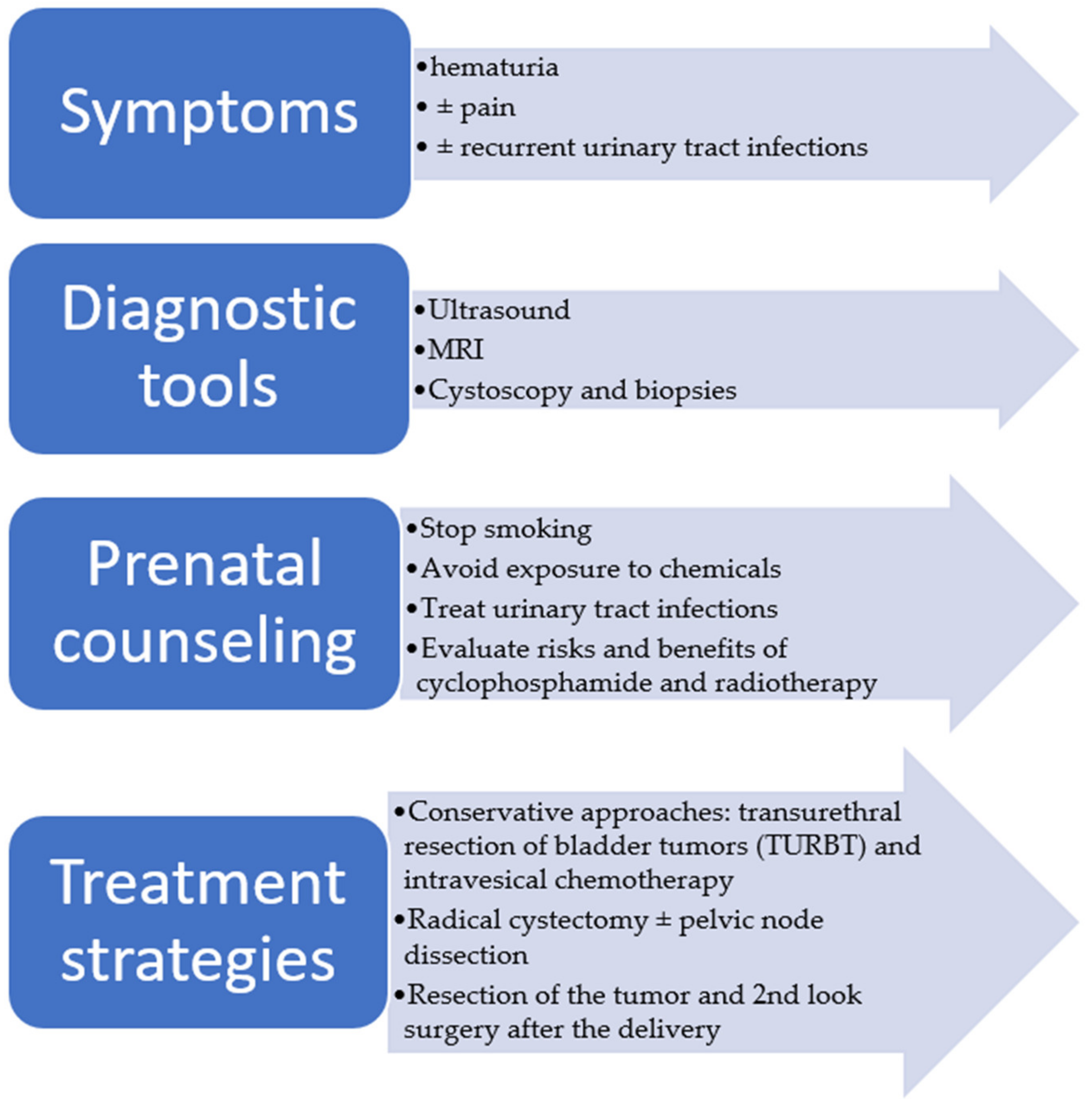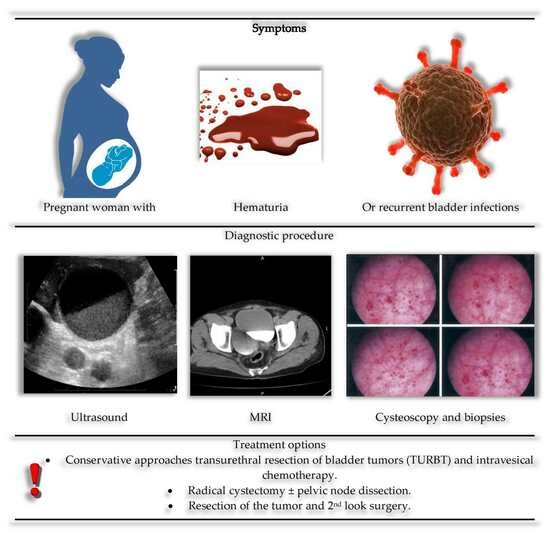Bladder Cancer during Pregnancy: A Review of the Literature
Abstract
:1. Introduction
2. Materials and Methods
3. Case Series
3.1. Case 1
3.2. Case 2
3.3. Case 3
3.4. Case 4
3.5. Case 5
3.6. Case 6
3.7. Case 7
3.8. Case 8
3.9. Case 9
3.10. Case 10
3.11. Case 11
3.12. Case 12
3.13. Case 13
| Author | Age of Pregnant Woman | Main Symptom | Week of Gestation Diagnosed | Pregnancy Outcome | Survival Outcome |
|---|---|---|---|---|---|
| Castrillo et al. [11] | 27 | Painless Macroscopic Hematuria | 18th week | Full term | No complications in pregnancy were reported. |
| Mitra et al. [12] | 37 | Occasional Recurrent Hematuria | 11th week | Delivery 40 w | Local recurrence after 4 months. |
| Muezzinoglu et al. [13] | 34 | Asymptomatic Bacteriuria without Hematuria | 20th week | Delivery 40 w | No recurrence was observed at the 2-year follow-up. |
| Shrotri et al. [14] | 36 | Gross Hematuria | 26th week | Emergency Caesarian section at 37+2 w | No recurrence after 6 months of follow-up. |
| Tyagi et al. [15] | 30 | Occasional Recurrent Gross Hematuria | 19th week | Delivery 35.5 w | No ultrasonographic recurrence was found after the labor. |
| Spahn et al. [16] | 36 | Occasional Vaginal Bleeding | 34th week | Delivery 39 w | No recurrence after 12 months of follow-up. |
| Spahn et al. [16] | 35 | No symptoms | 12th week | Delivery 40 w | Recurrence after 2 months. |
| Alleemudder et al. [17] | 39 | Painless Macroscopic Hematuria | 2nd trimester | Premature delivery (32 w) | Patient died—local recurrence of disease reported 6 weeks after surgery. |
| Church et al. [18] | 27 | Recurrent and Persistent Urinary Tract Infections, Microscopic Hematuria, Abdominal Pain | antepartum | Primary emergency delivery at 37 w | Patient died—local recurrence of disease reported 4 months after surgery. |
| Rojas et al. [19] | 31 | Urinary Tract Infections—Gross Hematuria | 6th month | Caesarian section at 30 w | No recurrence after 18 months of follow-up. |
| Spahn et al. [16] | 35 | Occasional Macroscopic Hematuria | 18th week | Pregnancy termination at 18 w | Patient died 2 months after the surgery. |
| Singh et al. [20] | 32 | Painless Macroscopic Hematuria | 26th week | Delivery 34 w | No recurrence after 12 months of follow-up. |
| Singh et al. [21] | 25 | Painless Macroscopic Hematuria | 36th week | Emergency caesarian section at 36+2 w | No recurrence after 3 months of follow-up. |
4. Discussion
5. Conclusions
Author Contributions
Funding
Institutional Review Board Statement
Informed Consent Statement
Acknowledgments
Conflicts of Interest
References
- Richters, A.; Aben, K.K.H.; Kiemeney, L.A.L.M. The global burden of urinary bladder cancer: An update. World J. Urol. 2020, 38, 1895–1904. [Google Scholar] [CrossRef]
- Hakulinen, T. Statistics in Medicine. In Cancer Incidence in Five Continents; Parkin, D.M., Whelan, S.L., Ferlay, J., Raymond, L., Young, J., Eds.; IARC Scientific Publications; Wiley Online Library: Lyon, France, 1997; Volume 7, p. 34+1240. ISBN 92-832-2143-5. Available online: https://onlinelibrary.wiley.com/doi/abs/10.1002/%28SICI%291097-0258%2820000515%2919%3A9%3C1261%3A%3AAID-SIM386%3E3.0.CO%3B2-L (accessed on 4 August 2023).
- Parkin, D.M.; Bray, F.; Ferlay, J.; Pisani, P. Estimating the world cancer burden: Globocan 2000. Int. J. Cancer 2001, 94, 153–156. [Google Scholar] [CrossRef]
- Mungan, N.A.; Aben, K.K.; Schoenberg, M.P.; Visser, O.; Coebergh, J.W.W.; Witjes, J.A.; Kiemeney, L.A. Gender differences in stage-adjusted bladder cancer survival. Urology 2000, 55, 876–880. [Google Scholar] [CrossRef]
- Jubber, I.; Ong, S.; Bukavina, L.; Black, P.C.; Compérat, E.; Kamat, A.M.; Kiemeney, L.; Lawrentschuk, N.; Lerner, S.P.; Meeks, J.J.; et al. Epidemiology of Bladder Cancer in 2023: A Systematic Review of Risk Factors. Eur. Urol. 2023, 84, 176–190. [Google Scholar] [CrossRef]
- Goldgar, D.E.; Easton, D.F.; Cannon-albright, L.A.; Skolnick, M.H. Systematic population-based assessment of cancer risk in first-degree relatives of cancer probands. J. Natl. Cancer Inst. 1994, 86, 1600–1608. [Google Scholar] [CrossRef]
- Kirkali, Z.; Chan, T.; Manoharan, M.; Algaba, F.; Busch, C.; Cheng, L.; Kiemeney, L.; Kriegmair, M.; Montironi, R.; Murphy, W.M.; et al. Bladder cancer: Epidemiology, staging and grading, and diagnosis. Urology 2005, 66 (Suppl. 1), 4–34. [Google Scholar] [CrossRef]
- Cantor, K.P.; Lynch, C.F.; Johnson, D. Bladder cancer, parity, and age at first birth. Cancer Causes Control 1992, 3, 57–62. [Google Scholar] [CrossRef]
- Plesko, I.; Dimitrova, E.; Somogyi, J.; Preston-Martin, S.; Day, N.E.; Tzonou, A. Parity and cancer risk in Slovakia. Int. J. Cancer 1985, 36, 529–533. [Google Scholar] [CrossRef]
- Boschi, F.; Malatesta, M. Nanoparticle-Based Techniques for Bladder Cancer Imaging: A Review. Int. J. Mol. Sci. 2023, 24, 3812. [Google Scholar] [CrossRef]
- Castrillo, A.H.; Peña, A.V.; De Diego Rodríguez, E.; Martín, A.C.; Mones, J.M.C. Hematuria during pregnancy caused by bladder tumour. Report of 2 cases]. Actas Urol. Esp. 2005, 29, 981–984. [Google Scholar] [CrossRef]
- Mitra, S.; Williamson, J.G.; Bullock, K.N.; Arends, M. Bladder cancer in pregnancy. J. Obstet. Gynaecol. 2004, 23, 440–442. [Google Scholar] [CrossRef]
- Muezzinoglu, T.; Inceboz, U.; Baytur, Y.; Nese, N. Bladder carcinoma in pregnancy: Unusual cause for frequent urinary tract infection--case report. Arch Gynecol. Obstet. 2013, 287, 833–834. [Google Scholar] [CrossRef]
- Shrotri, K.N.; Ross, G.C. Bladder carcinoma presenting during twin pregnancy. J. Obstet. Gynaecol. 2008, 28, 750–751. [Google Scholar] [CrossRef]
- Tyagi, S.; Nelivigi, G.; Bhagat, S. Management of Bladder Cancer in the Second Trimester of Pregnancy. J. Obstet. Gynaecol. India 2019, 69 (Suppl. 1), 20. [Google Scholar] [CrossRef]
- Spahn, M.; Bader, P.; Westermann, D.; Echtle, D.; Frohneberg, D. Bladder Carcinoma during Pregnancy. Urol. Int. 2005, 74, 153–159. [Google Scholar] [CrossRef]
- Alleemudder, D.I.; Alleemudder, A.I.; Harry, D.; Fountain, S. Bladder squamous cell carcinoma in pregnancy. J. Obstet. Gynaecol. 2016, 36, 388–389. [Google Scholar] [CrossRef]
- Church, E.; Dieh, A. A rare case of aggressive squamous cell carcinoma of the bladder in pregnancy. Obstet. Med. 2013, 6, 182–183. [Google Scholar] [CrossRef]
- Rojas, P.A.; González, C.; Mendez, G.P.; Majerson, A.; Francisco, I.F.S. Bladder squamous cell carcinoma in a pregnant woman: Case report and review of the literature. BMC Urol. 2021, 21, 4. [Google Scholar] [CrossRef]
- Singh, G.; Chawla, S.; Nandy, P.; Rajput, M. A Large Bladder Tumor During Pregnancy: Twin Challenge. J. Urol. Surg. 2022, 9, 146–149. [Google Scholar] [CrossRef]
- Singh, V.; Kumar, M.; Singh, U.; Singh, G.; Singh, M.K. Bladder Carcinoma with Life Threatening Hematuria during Pregnancy: A Therapeutic Challenge Bladder Carcinoma & Pregnancy. Clin. Case Rep. Int. 2022, 6, 1260. Available online: http://clinicalcasereportsint.com/ (accessed on 4 August 2023).
- Aragon-Ching, J.B.; Werntz, R.P.; Zietman, A.L.; Steinberg, G.D. Multidisciplinary Management of Muscle-Invasive Bladder Cancer: Current Challenges and Future Directions. Am. Soc. Clin. Oncol. Educ. Book 2018, 38, 307–318. [Google Scholar] [CrossRef]
- Pham, H.; Torres, H.; Sharma, P. Mental health implications in bladder cancer patients: A review. Urol. Oncol. 2019, 37, 97–107. [Google Scholar] [CrossRef]
- Applegate, K.E.; Findlay, Ú.; Fraser, L.; Kinsella, Y.; Ainsbury, L.; Bouffler, S. Radiation exposures in pregnancy, health effects and risks to the embryo/foetus-information to inform the medical management of the pregnant patient. J. Radiol. Prot. 2021, 41, S522–S539. [Google Scholar] [CrossRef]
- DeSouza, K.; Chowdhury, S.; Hughes, S. Prompt diagnosis key in bladder cancer—PubMed. Practitioner 2014, 258, 23–27. Available online: https://pubmed.ncbi.nlm.nih.gov/24617100/ (accessed on 12 September 2023).
- Bayne, C.E.; Farah, D.; Herbst, K.W.; Hsieh, M.H. Role of urinary tract infection in bladder cancer: A systematic review and meta-analysis. World J. Urol. 2018, 36, 1181–1190. [Google Scholar] [CrossRef]
- Galgano, S.J.; Rais-Bahrami, S.; Porter, K.K.; Burgan, C. The Role of Imaging in Bladder Cancer Diagnosis and Staging. Diagnostics 2020, 10, 703. [Google Scholar] [CrossRef]
- Gharibvand, M.; Kazemi, M.; Motamedfar, A.; Sametzadeh, M.; Sahraeizadeh, A. The role of ultrasound in diagnosis and evaluation of bladder tumors. J Fam. Med. Prim. Care 2017, 6, 840. [Google Scholar] [CrossRef]
- Hollenbeck, B.K.; Dunn, R.L.; Ye, Z.; Hollingsworth, J.M.; Skolarus, T.A.; Kim, S.P.; Montie, J.E.; Lee, C.T.; Wood, D.P., Jr.; Miller, D.C. Delays in diagnosis and bladder cancer mortality. Cancer 2010, 116, 5235–5242. [Google Scholar] [CrossRef]

Disclaimer/Publisher’s Note: The statements, opinions and data contained in all publications are solely those of the individual author(s) and contributor(s) and not of MDPI and/or the editor(s). MDPI and/or the editor(s) disclaim responsibility for any injury to people or property resulting from any ideas, methods, instructions or products referred to in the content. |
© 2023 by the authors. Licensee MDPI, Basel, Switzerland. This article is an open access article distributed under the terms and conditions of the Creative Commons Attribution (CC BY) license (https://creativecommons.org/licenses/by/4.0/).
Share and Cite
Peteinaris, A.; Perros, P.; Prokopakis, I.; Fasoulakis, Z.; Ntounis, T.; Daglas, K.; Kostopoulou, I.E.; Samara, A.A.; Pagonis, K.; Tatanis, V.; et al. Bladder Cancer during Pregnancy: A Review of the Literature. J. Pers. Med. 2023, 13, 1418. https://doi.org/10.3390/jpm13091418
Peteinaris A, Perros P, Prokopakis I, Fasoulakis Z, Ntounis T, Daglas K, Kostopoulou IE, Samara AA, Pagonis K, Tatanis V, et al. Bladder Cancer during Pregnancy: A Review of the Literature. Journal of Personalized Medicine. 2023; 13(9):1418. https://doi.org/10.3390/jpm13091418
Chicago/Turabian StylePeteinaris, Angelis, Paraskevas Perros, Ioannis Prokopakis, Zacharias Fasoulakis, Thomas Ntounis, Konstantinos Daglas, Ira Eirini Kostopoulou, Athina A. Samara, Konstantinos Pagonis, Vasileios Tatanis, and et al. 2023. "Bladder Cancer during Pregnancy: A Review of the Literature" Journal of Personalized Medicine 13, no. 9: 1418. https://doi.org/10.3390/jpm13091418
APA StylePeteinaris, A., Perros, P., Prokopakis, I., Fasoulakis, Z., Ntounis, T., Daglas, K., Kostopoulou, I. E., Samara, A. A., Pagonis, K., Tatanis, V., Faria-Costa, G., Xhaferi, R., Arzumanyan, K., Martínez, B. B., Chionis, A., Pergialiotis, V., Daskalakis, G., Kontomanolis, E. N., & Koutras, A. (2023). Bladder Cancer during Pregnancy: A Review of the Literature. Journal of Personalized Medicine, 13(9), 1418. https://doi.org/10.3390/jpm13091418










